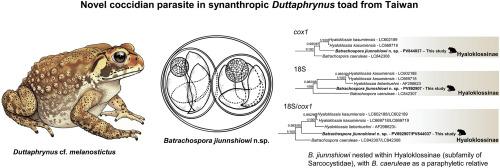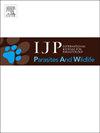文章题目台湾大蟾一新种(顶复合体亚:肉囊虫科)
IF 2.2
3区 医学
Q3 ECOLOGY
International Journal for Parasitology-Parasites and Wildlife
Pub Date : 2025-09-11
DOI:10.1016/j.ijppaw.2025.101136
引用次数: 0
摘要
尽管寄主多样性很高,但两栖动物球虫的研究仍然很少,在综合分类文献方面存在重大空白。本研究描述了一种感染台湾亚洲黑棘蟾蜍(Duttaphrynus cf.melanotictus)的新型球虫寄生虫Batrachospora jiunnshiowi n. sp.(顶复合体目:肉囊虫科)。形态学特征显示:卵囊呈孢子状,平均长×宽= 15.9 × 14.1 μm,长/宽比= 1.1,n = 50;卵囊呈椭圆形(10.8 × 8.0 μm,长/宽= 1.35,n = 66),不含孢子体,内含独特的水滴状孢子子,与同类卵囊具有明显的自异形特征。所有数据集的系统发育分析(18S核糖体RNA,细胞色素c氧化酶亚基1,串联序列)都被牢固地定位在玻光菌亚科中,尽管形态符合Batrachospora的诊断标准,但与B. caeruleae相关。黑纹伊蚊东部系的感染率为13.3%(2/15个宿主),是该宿主第一个具有分子特征的球虫。结合形态计量学、宿主特异性和多位点系统发育的综合分类方法验证了其作为新种的地位。这一发现强调了在共生两栖动物中未记载的球虫多样性,并提倡扩大监测以澄清宿主-寄生虫的共同进化。本文章由计算机程序翻译,如有差异,请以英文原文为准。

A new Batrachospora species (Apicomplexa: Sarcocystidae) from Duttaphrynus toad in Taiwan
Coccidia of amphibians remain poorly studied despite high host diversity, with critical gaps in integrative taxonomic documentation. This study describes Batrachospora jiunnshiowi n. sp. (Apicomplexa: Sarcocystidae), a novel coccidian parasite infecting the Asian black-spined toad (Duttaphrynus cf. melanostictus) in Taiwan. Morphological characterization revealed sporulated oocysts (mean L × W = 15.9 × 14.1 μm; L/W ratio = 1.1; n = 50) with ellipsoidal sporocysts (10.8 × 8.0 μm; L/W = 1.35; n = 66) lacking Stieda bodies and containing unique drop-shaped sporozoites—an autapomorphy distinguishing it from congeners. Phylogenetic analyses of all datasets (18S ribosomal RNA, cytochrome c oxidase subunit 1, concatenated sequences) robustly placed within the subfamily Hyaloklossinae, demonstrating paraphyly relative to B. caeruleae despite morphological conformity to Batrachospora diagnostic criteria. Prevalence was 13.3 % (2/15 hosts) in the eastern lineage of D. melanostictus, representing the first molecularly characterized coccidian in this host. The integrative taxonomic approach combining morphometrics, host specificity, and multi-locus phylogenetics validates its status as a new species. The discovery underscores significant undocumented coccidian diversity in synanthropic amphibians and advocates expanded surveillance to clarify host-parasite coevolution.
求助全文
通过发布文献求助,成功后即可免费获取论文全文。
去求助
来源期刊

International Journal for Parasitology-Parasites and Wildlife
Medicine-Infectious Diseases
CiteScore
3.80
自引率
5.60%
发文量
113
审稿时长
45 days
期刊介绍:
The International Journal for Parasitology: Parasites and Wildlife (IJP-PAW) publishes the results of original research on parasites of all wildlife, invertebrate and vertebrate. This includes free-ranging, wild populations, as well as captive wildlife, semi-domesticated species (e.g. reindeer) and farmed populations of recently domesticated or wild-captured species (e.g. cultured fishes). Articles on all aspects of wildlife parasitology are welcomed including taxonomy, biodiversity and distribution, ecology and epidemiology, population biology and host-parasite relationships. The impact of parasites on the health and conservation of wildlife is seen as an important area covered by the journal especially the potential role of environmental factors, for example climate. Also important to the journal is ''one health'' and the nature of interactions between wildlife, people and domestic animals, including disease emergence and zoonoses.
 求助内容:
求助内容: 应助结果提醒方式:
应助结果提醒方式:


